See Mars Through a Telescope
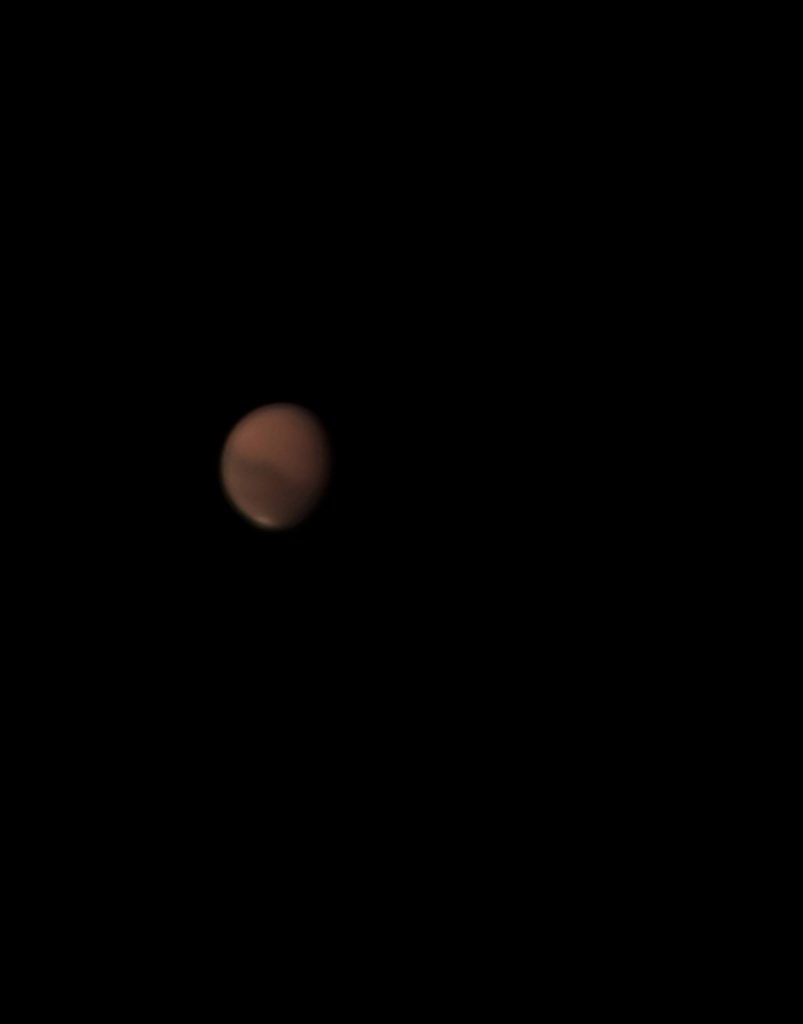
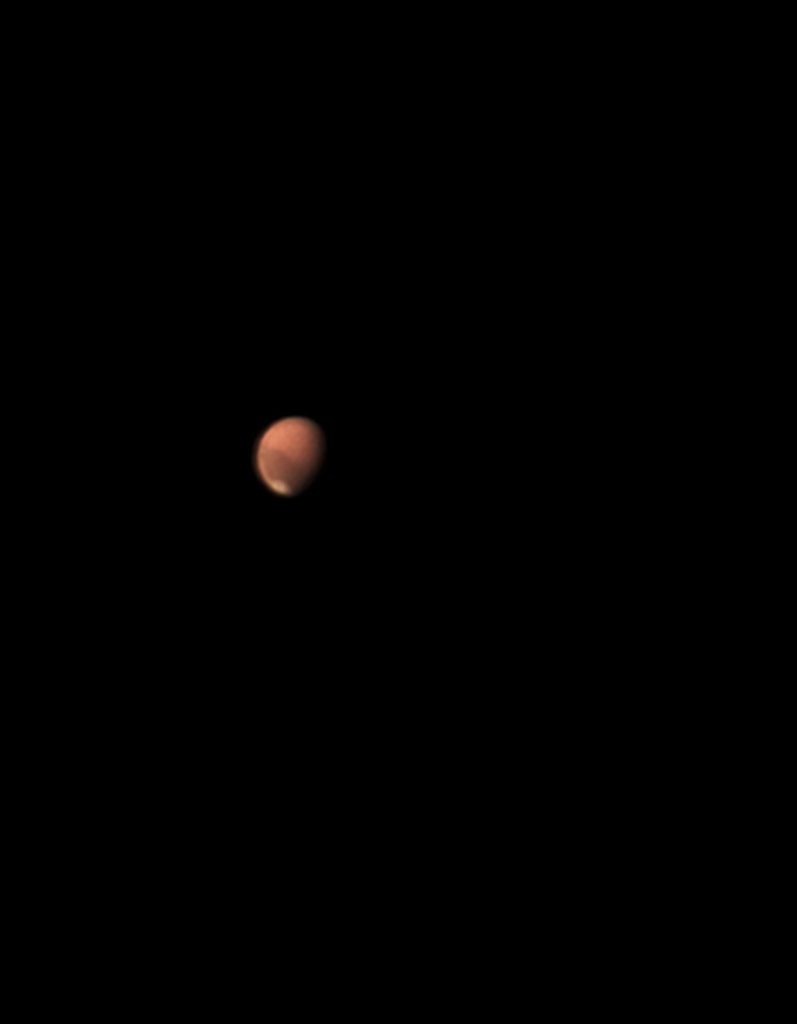
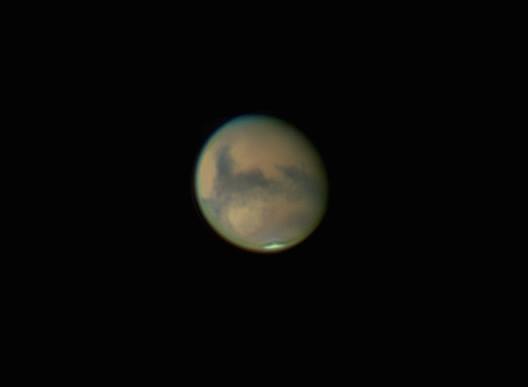
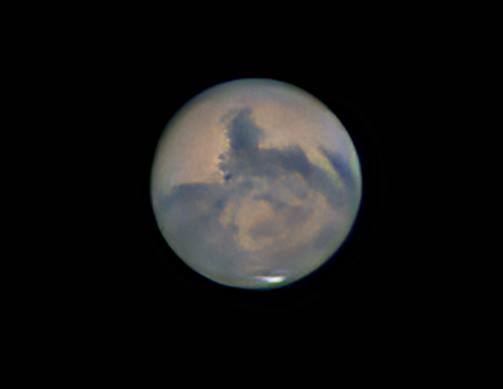
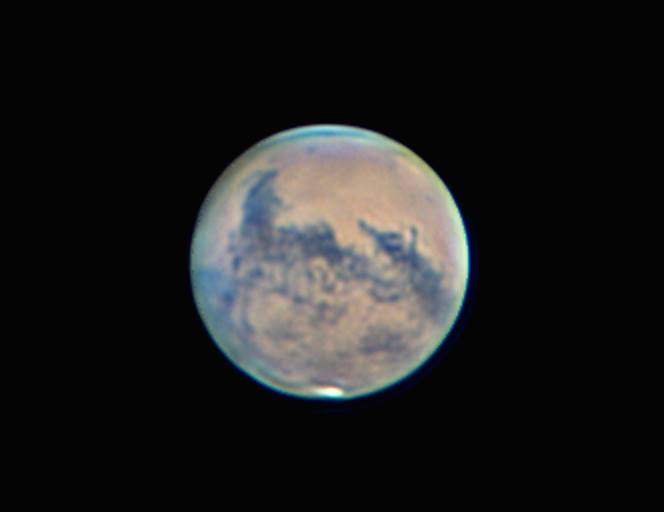
Mars is a fourth planet from the sun. Mars is visible through a telescope, making it an attractive target for amateur astronomers. Even a small telescope with a diameter of 60 mm (2.4 inches) can provide a view of Mars, including its reddish hue, polar ice caps, and darker regions. The best time to view Mars is during opposition, an event that occurs every 26 months when Mars is closest to Earth and particularly visible in the night sky. Larger telescopes with an aperture of 4 inches or more provide a more detailed view of Mars’ unique surface features, such as Olympus Mons and Valles Marineris. Good viewing conditions are essential for observing Mars’ details, with the best conditions occurring when Mars is high in the sky.
When looking at Mars through a telescope, it appears as a small, bright, orange-red disk due to the iron oxide particles on its surface. Distinct surface features can be seen, including the polar ice caps, which appear as bright white patches, and the dark regions or “maria” that are vast plains of volcanic rock and sand. Mars has a thin, white atmosphere composed mainly of carbon dioxide, which can sometimes be seen as a faint, hazy layer surrounding the planet. Dust storms on Mars can make the planet appear hazier or cloudy, obscuring some surface features. The appearance of Mars changes with its position in its orbit and its distance from Earth, with more detail visible at closer approaches.
The Celestron NexStar 130SLT Computerized Telescope is considered the best for viewing Mars due to its exceptional clarity and detail. Its large 130mm (5.1 inches) aperture allows it to gather more light for a brighter image, and its 650mm (25.6 inches) focal length provides a wider field of view and more detailed image of the planet’s surface. The telescope’s computerized altazimuth mount enables easy tracking and location of Mars as it moves across the night sky. Other recommended telescopes for viewing Mars include the Celestron NexStar 8SE and an 8″ Dobsonian, as well as refractor telescopes, Schmidt-Cassegrain, and Maksutov-Cassegrain telescopes. High power (175x or more) is recommended for optimal detail when viewing Mars, and specific eyepieces and filters can enhance the viewing experience.
Viewers can catch a live view of Mars through a telescope using various websites and institutions. Slooh, a robotic telescope service, offers live views of Mars and other celestial objects through their website or mobile app. NASA’s Jet Propulsion Laboratory occasionally provides live telescope feeds of Mars during significant exploration events. The Mars Society and the Virtual Telescope Project also offer live views of Mars, with events usually announced in advance. Local astronomy clubs and observatories may also provide live telescope feeds of Mars.
Can you see Mars with a telescope?
Yes, you can see Mars with a telescope. Even a telescope as small as 60 mm (2.4 inches) in diameter can provide a view of the Red Planet. You can see Mars’ reddish hue, its polar ice caps, and some of its darker regions when looking through a telescope at night. The best time for viewing Mars is during opposition, an event that occurs every 26 months when Earth and Mars are on opposite sides of the Sun, making Mars closest to Earth and particularly visible in the night sky.
Using a larger telescope, with an aperture of 4 inches or more, allows for a more detailed view of Mars’ surface. High magnification provides the most detail, enabling the observation of Mars’ unique surface features. These include Olympus Mons, the largest volcano in the solar system, and the Valles Marineris canyon system, which stretches over 4,000 km (2,500 miles) across the Martian surface. Mars’ apparent diameter can reach 6 arcseconds or more during opposition, making it a viable target for medium and large telescopes.
The viewing conditions play a significant role in seeing Mars’ details. The atmospheric seeing conditions are best when Mars is high in the sky, providing a clearer, more real view. The seeing conditions are measured in arcseconds, with a value of 1-2 arcseconds indicating excellent seeing, and a value of 5-6 arcseconds indicating poor seeing. Observing Mars requires practice and patience. Mars is a small, low-contrast, and red planet that demands a lot from a scope.
Can you see Mars without a telescope?
Mars can indeed be seen from Earth without the aid of a telescope. Mars is visible to the naked eye when it is at its brightest, a spectacle that transforms the night sky into a captivating tableau.
Mars appears as a bright red dot in the night sky, a beacon that stands out among the myriad of stars. This brightness occurs every 26 months, a phenomenon known as opposition. Mars is on the opposite side of the Earth from the Sun during opposition, making it more visible than usual. With a magnitude of around -2.5, Mars outshines most stars, making it a conspicuous object in the night sky.
What does Mars look like with a telescope?
When you look at Mars through a telescope, it appears as a small, bright, orange-red disk. This color is due to the iron oxide particles present on its surface, giving it a distinct hue that sets it apart from other celestial bodies.
The most prominent visual features of Mars are the polar ice caps, which appear as bright white patches at the planet’s poles. These ice caps are composed of water ice and frozen carbon dioxide, and their size varies with the Martian seasons. Dark regions known as “maria” can be seen on the planet’s surface. These vast plains of volcanic rock and sand appear as large, dark patches, with Syrtis Major and Hellas Basin being among the most notable examples.
Mars has a thin, white atmosphere, primarily composed of carbon dioxide. This atmosphere can be seen as a faint, hazy layer surrounding the planet. Dust storms can occur on Mars, making the planet appear even hazier or cloudy, which can obscure some of the surface features.
The appearance of Mars through a telescope changes with its position in its orbit and its distance from Earth. At its closest approach to Earth, Mars can be seen in greater detail, offering a more rewarding viewing experience. When Mars is farther away, it appears smaller and less detailed.
What is the best telescope to see Mars?
The best telescope to see Mars clearly is the Celestron NexStar 130SLT Computerized Telescope. This telescope offers exceptional clarity and detail when observing Mars, making it the ideal choice for those looking to view the Red Planet.
One of the key features of the Celestron NexStar 130SLT is its aperture. With a 130mm (5.1 inches) aperture, the telescope has a larger light collecting area, allowing it to gather more light and provide a brighter image of Mars. This is essential for viewing Mars, as the planet can be quite dim and difficult to see in smaller telescopes.
NexStar 130SLT telescope has a 650mm (25.6 inches) focal length, which provides a wider field of view and a more detailed image of the planet’s surface. This makes it easier to see Mars’ polar ice caps, rust-red color, and prominent geological features like Valles Marineris.
The telescope’s computerized altazimuth mount is a major advantage. This mount enables easy tracking of Mars, allowing you to follow the planet as it moves across the night sky. The mount makes it easy to locate Mars, ensuring that you can find the planet quickly and easily.
While the Celestron NexStar 130SLT is the best telescope for viewing Mars, there are other options available. The Celestron NexStar 8SE is a highly recommended telescope for planetary viewing, while an 8″ Dobsonian is considered the best value for the price. Refractor telescopes are ideal for viewing planets, with a 4-6 inch aperture refractor with an equatorial mount being a great option. Schmidt-Cassegrain and Maksutov-Cassegrain telescopes are excellent choices for planetary observers and imagers.
To see Mars in optimal detail, it is recommended to use high power (175x or more). The Apertura 10mm Super Wide Angle eyepiece and the Explore Scientific 6.5mm 52 degree eyepieces are both great options to see Mars. A green #58 filter can help spot darker areas on Mars and make the polar caps pop into view.
Where to see telescope live view of Mars?
There are several options to observe Mars through the live telescope view.
Slooh offers live views of Mars, allowing viewers to witness the red planet in real-time. Slooh’s services are not limited to Mars; they provide glimpses of other celestial objects. To access these live feeds, you can visit their website or use their mobile app. A subscription is required, although they do offer a free trial period.
NASA’s Jet Propulsion Laboratory (JPL) is another excellent resource for live telescope views of Mars. While these feeds are not always available, JPL occasionally provides live telescope feeds during significant Mars exploration events. To stay updated, keep an eye on JPL’s website for announcements about upcoming events and live streams.
The Mars Society, a non-profit organization dedicated to promoting the exploration and settlement of Mars, occasionally hosts live telescope feeds of the red planet. These events are usually announced in advance, so it’s beneficial to register to receive notifications from them.
The Virtual Telescope Project, a non-profit organization that operates a remote-controlled telescope, offers live views of Mars. Like the Mars Society, they announce their events ahead of time, so it’s a good idea to regularly check their website for upcoming events and live streams.
Many astronomy clubs and observatories may offer live telescope feeds of Mars. Reach out to these organizations in your area to inquire about potential live feeds and other viewing opportunities. With these resources, you can embark on a thrilling journey of discovery, observing Mars live through a telescope from the comfort of your home or under the expansive night sky.
How to see Mars?
To see Mars, follow the steps listed below.
- Look for Mars high in the sky before dawn, particularly in the eastern morning twilight.
- Find Mars near the waning crescent moon on specific dates.
- Use resources such as Google Maps, star parties, or planetariums to locate Mars.
- Mars is visible to the naked eye, but using a telescope or binoculars will help you see more detail.
- Use a telescope with an aperture of at least 60 mm (2.4 inches) and a magnification power of 100x to 200x for the best view.
- Mars is best visible from Earth when it’s at opposition, which occurs every 26 months.
- Choose a clear night with minimal cloud cover and moonlight for optimal viewing conditions.
- Use planetarium software or apps like Stellarium or SkySafari to determine Mars’ position in the sky.
- Set up your telescope and focus it on Mars to bring it into sharp view.
- Observe Mars’ polar ice caps, equatorial region, and prominent features like Valles Marineris or Olympus Mons.
- Check the seeing conditions in your area using online resources like Clear Sky Chart or the Astronomical Seeing Conditions Forecast.
- Be patient and enjoy the experience of observing Mars up close.
To see Mars, start by looking for it high in the sky before dawn, particularly in the eastern morning twilight. You can find Mars near the waning crescent moon on specific dates or use resources such as Google Maps, star parties, or planetariums to locate it. Mars is visible to the naked eye, but using a telescope or binoculars will help you see more detail on its surface.
A telescope with an aperture of at least 60 mm (2.4 inches) and a magnification power of 100x to 200x is recommended for the best view of Mars. It is important to note that Mars is best visible from Earth when it’s at opposition, which occurs every 26 months. During opposition, Mars is on the opposite side of the Earth from the Sun and is visible in the night sky.
When planning to see Mars, choose a clear night with minimal cloud cover and moonlight for optimal viewing conditions. You can use planetarium software or apps like Stellarium or SkySafari to determine Mars’ position in the sky. Once you have located Mars, set up your telescope and focus it on the planet to bring it into sharp view.
Through your telescope, you might observe Mars’ polar ice caps, equatorial region, and prominent features like Valles Marineris or Olympus Mons. It is important to check the seeing conditions in your area using online resources like Clear Sky Chart or the Astronomical Seeing Conditions Forecast. Seeing refers to the quality of the Earth’s atmosphere, which affects the sharpness and clarity of the image.
What magnification to see Mars?
Magnification of over 100x is necessary to see details on Mars. This is because Mars is a small and distant object, and a telescope with sufficient power is required to see its markings clearly. According to a study by researchers at the University of Arizona, a minimum magnification of 120x is recommended to see anything on Mars. This is the magnification at which the planet’s surface features, such as its polar ice caps and dark markings, become visible.
Higher magnifications provide more detail, allowing observers to see smaller features on the planet’s surface. The highest usable magnification depends on several factors, including the seeing conditions and the aperture of the telescope. A good rule of thumb for magnification is 30-50x per inch of aperture for nights of average seeing. This means that a telescope with a 4-inch aperture would require a magnification of 120x to 200x to see Mars clearly. For nights of good seeing, a magnification of 50-70x per inch of aperture is recommended.
Experienced observers may use magnifications up to 125x to 225x, depending on the seeing conditions and the quality of their telescope. The maximum usable magnification is limited by the aperture of the telescope. A larger aperture allows for higher magnifications, as it collects more light and provides a clearer image. The maximum usable magnification is limited by atmospheric seeing, which is the stability of the Earth’s atmosphere. Poor seeing conditions can cause the image to become distorted and blurry, making higher magnifications unusable.
The best magnification for viewing Mars depends on the size of the telescope. For telescopes up to 7 inches in aperture, a magnification of 35x per inch of aperture is recommended. This means that a 7-inch telescope would require a magnification of 245x to see Mars clearly. Magnification of roughly 25x to 30x per inch of aperture is recommended for larger telescopes to see Mars. This means that a 10-inch telescope would require a magnification of 250x to 300x to see Mars clearly.
The practical limit of magnification is around 150x, as higher magnifications can cause the image to become too dim and difficult to see. This limit can be pushed with the use of a Barlow lens or a 6mm 66° eyepiece, which can increase the magnification of the telescope without sacrificing image quality.
Can we see Mars curiosity rover from earth with telescope?
Observing the Mars Curiosity rover from Earth with a telescope is not possible with current technology. The primary challenge lies in the rover’s size and the vast distance between Earth and Mars. The Curiosity rover, about the size of a small car, measures approximately 3 meters (10 feet) in length and 2.2 meters (7.2 feet) in width. Mars is located millions of miles away, with its closest approach to Earth being around 35 million miles (56 million kilometers) and its farthest at approximately 250 million miles (401 million kilometers).
Even the most advanced telescopes available today, such as the Hubble Space Telescope and the Atacama Large Millimeter/submillimeter Array (ALMA), lack the required resolution and magnification power to observe an object as small as the Curiosity rover on Mars. The Earth’s atmosphere further complicates the observation by causing distortion. To see the rover from Earth, a telescope would need an extraordinarily high resolution of about 10 milliarcseconds, which is far beyond the capabilities of current technology. Therefore, observing the Mars Curiosity rover from Earth with a telescope remains an unattainable feat.
